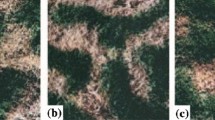Abstract
We construct a spatial model that incorporates Allee-type and competition interactions for vegetation as an evolving random field of biomass density. The cumulative effect of close-range precipitation-dependent interactions is controlled by a parameter defining precipitation frequency. We identify a narrow parameter range in which the behavior of the system changes from survival of vegetation to extinction, via a transitional aggregation pattern. The aggregation pattern is tied to the initial configuration and appears to arise differently from Turing’s diffusion and differential flow patterns of other models. There is close agreement of our critical transition parameter range with that of the corresponding evolving random mean-field model.








Similar content being viewed by others
Data availability
The MATLAB codes used for the simulations are available from https://github.com/LuisFGordillo/codes
References
Bashan Y, de-Bashan LE (2010) Microbial populations of arid lands and their potential for restoration of deserts. In: Dion P (ed) Soil biology and agriculture in the tropics. Soil Biology, vol 21. Springer, Berlin
Borgogno F, D’Odorico P, Laio F, Ridolfi L (2009) Mathematical models of vegetation pattern formation in ecohydrology. Rev Geophys 47:RG1005
Buceta J, Lindemberg K, Parrondo JMR (2002) Pattern formation induced by nonequilibrium global alternation dynamics. Phys Rev E 66:036216
Buceta J, Lindemberg K (2002) Switching-induced Turing instability. Phys Rev E 66:046202
Chen Y, Kolokolnikov T, Tzou J, Gai C (2015) Patterned vegetation, tipping points, and the rate of climate change. Eur J Appl Math. Available on CJO 2015 https://doi.org/10.1017/S0956792515000261
Courchamp F, Berec L, Gascoigne J (2008) Allee effects in ecology and conservation. Oxford University Press, Oxford
D’Odorico P, Laio F, Ridolfi L (2006) Vegetation patterns induced by random climate functions. Geophys Res Lett 33:L19404
Gandhi P, Iams S, Bonetti S, Silber M (2019) Vegetation pattern formation in drylands. In: D’Odorico P, Porporato A, WilkinsonRunyan C (eds) Dryland Ecohydrology. Springer, Cham
Gandhi P, Liu L, Silber M (2023) A pulsed-precipitation model of dryland vegetation pattern formation. SIAM J Appl Dyn Syst (in print)
Klausmeier CA (1999) Regular and irregular patterns in semiarid vegetation. Science 284:1826–1828
Levefer R, Lejeune O (1997) On the origin of the tiger bush. Bull Math Biol 59:263–294
Lejeune O, Tlidi M, Couteron P (2002) Localized vegetation patches: a self-organized response to resource scarcity. Phys Rev E 66:010901(R)
Lewis M, Petrovskii S, Potts J (2016) The mathematics behind biological invasions. Springer, Cham
Li Y, Johnston ST, Buenzli PR, van Heijster P, Simpson M (2022) Extinction of bistable populations is affected by the shape of their initial spatial distribution. Bull Math Biol 84:21
Martínez-García R, Calabrase JM, Hernández-García E, López C (2013) Vegetation pattern formation in semiarid systems without facilitative mechanisms. Geophys Res Lett 40:6143–6147
Meron E (2015) Nonlinear physics of ecosystems. CRC Press, Boca Raton
Murray JD (2007) Mathematical biology: I. An Introduction, 3rd edn. Springer, New York
Rodríguez-Iturbe I, Porporato A (2005) Ecohydrology of water-controlled ecosystems. Cambridge University Press, Cambridge
Odum EP (1959) Fundamentals of ecology, 2nd edn. W.B. Saunders Company, Philadelphia
Ridolfi L, Laio F, D’Odorico P (2008) Fertility island formation and evolution in dryland ecosystems. Ecol Soc 13(1):5
Ridolfi L, D’Odorico P, Laio F (2011) Noise-induced phenomena in the environmental sciences. Cambridge University Press, Cambridge
Schlesinger WH, Pilmanis AM (1998) Plant-soil interactions in deserts. Biogeochemistry 42:169–187
Surendran A, Plank MJ, Simpson MJ (2020) Population dynamics with spatial structure and an Allee effect. Proc R Soc. A. 476:20200501
Sun G-Q et al (2021) Mathematical modeling and mechanisms of pattern formation in ecological systems: a review. Nonlinear Dyn 104:1677–1696
Volterra V (1938) Population growth, equilibria, and extinction under specified breeding conditions. Hum Biol 10(1):1–11
von Hardenberg J, Meron E, Shachak M, Zarmi Y (2001) Diversity of vegetation patterns and desertification. Phys Rev Lett 87:198101
Acknowledgements
We thank the referees for several suggestions leading to improvement of the manuscript.
Author information
Authors and Affiliations
Corresponding author
Additional information
Publisher's Note
Springer Nature remains neutral with regard to jurisdictional claims in published maps and institutional affiliations.
Rights and permissions
Springer Nature or its licensor (e.g. a society or other partner) holds exclusive rights to this article under a publishing agreement with the author(s) or other rightsholder(s); author self-archiving of the accepted manuscript version of this article is solely governed by the terms of such publishing agreement and applicable law.
About this article
Cite this article
Gordillo, L.F., Greenwood, P.E. Intermittent Precipitation-Dependent Interactions, Encompassing Allee Effect, May Yield Vegetation Patterns in a Transitional Parameter Range. Bull Math Biol 85, 86 (2023). https://doi.org/10.1007/s11538-023-01191-y
Received:
Accepted:
Published:
DOI: https://doi.org/10.1007/s11538-023-01191-y




